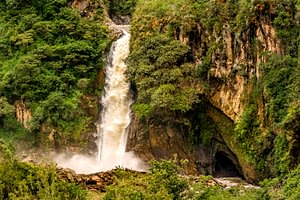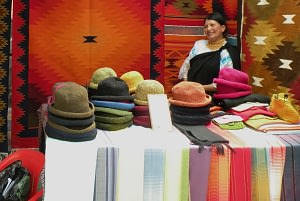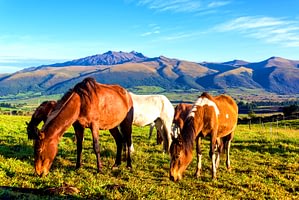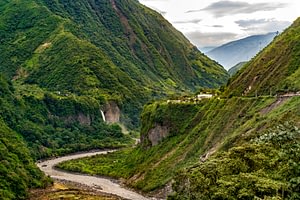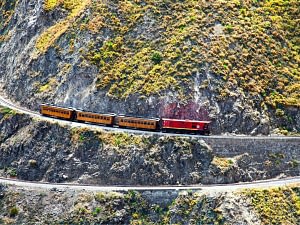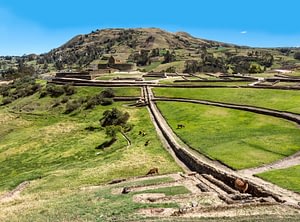Although Ecuador may be small, it's a destination that's got it all! Explore the highlights of Ecuador, from its rich cultural heritage, to its fine food and Amazon jungle. Read more below about our favourite places and things to discover during a trip to this diverse Central-American country. When you're ready to plan your own adventure, you can choose from our suggested itineraries and combine with our responsible experiences for a memorable holiday with a positive impact to boot.
The capital sits high in the Andes at 2,850 metres above sea level. Quito’s old town is one of South America's greatest surviving monuments to the colonial era, full of incredible architecture dating back to the 17th Century, with hidden squares and ancient churches waiting to be discovered.
Quito is also situated more or less directly on the equator and a 20 minute journey from the city centre will take you to the Equatorial Monument. Funnily enough, the monument doesn’t actually sit on the line, so after you’ve taken a dramatic picture, make sure to visit the fascinating museum which does!
Although Quito will captivate your imagination through its architecture and vibrant modern culture, it never lets you forget where you are. Surrounded by mountains on three sides, the city sits at the base of Mount Pichincha and a short cable car ride offers an unforgettable vista over the city.
If your days have not been busy enough, then Quito also offers fantastic nightlife which will show you everything great about modern Ecuador. Whether you are looking for a good meal, fun bars or some serious dancing, Quito has something for everyone.
Ecuador’s Amazon is both relatively accessible and home to some of the best lodges to be found in the rainforest. Within a few hours travel from Quito you can be surrounded encased under its vast canopy, ready to see some its huge array of wildlife including black caymans, pink river dolphins, giant river otters, harpy eagles, scarlet macaws, anacondas and a variety of lovely creepy crawlies. Ecuador has protected nearly 7.5 million acres of rainforest, including the UNESCO Biosphere reserve of Yasuní and the Limonchocha and Cuyabena reserves, supporting nearly 1000 species of birds.
The Amazon is also home to many different Amerindian communities. Some have managed to stay hidden from modern society, whilst others have decided to raise money and develop stunning tourist lodges, including Yachana Lodge and the Napo Wildlife Centre. These lodges are your opportunity to get a real insight into the natural wanders of the Amazon rainforest and the lives of the communities that live there. You can spend your days exploring the rainforest on foot or by dugout canoe, relaxing on your balcony with a glass of wine, or meeting some of the local piranha population swimming in the river!
Otavalo lies about one and a half hours north of Quito and is one of the best places in the Andes to experience modern day Inca and Quechua cultures. At Otavalo market you will see people from all over the surrounding countryside come to trade in everything from livestock to antiques to colourful Andean knitwear.
Surrounded by beautiful countryside, many people only stay in Otavalo to visit the market for the day or at most the night. However we believe the area offers so much more - beautiful old haciendas, fantastic horse riding and crystal clear volcanic lakes, making Otavalo well worth a few days' exploration. The historic centre is a must for lovers of fine art and religious architecture, where many buildings date from the 17th century and include fine examples of baroque style.
Perhaps the most dramatic of all of Ecuador’s attractions is the stunning natural formation known as the ‘Avenue of the Volcanoes’. This line of mountains and volcanoes is the backbone of Ecuador and runs south from the capital Quito. The Avenue of the Volcanoes includes the sensational Cotopaxi volcano and Chimborazo - actually the highest peak in the world as it sits on the Equator and its peak is further from the centre of the earth than Everest!
Ecuador and the Galapagos Islands are home to more than 70 volcanoes, of which around 60 are on the mainland and most of these you can see driving through the Avenue. This area of Ecuador is also home to many diverse indigenous communities with their own vibrant traditions. Dozens of markets can be found along the way and trading in anything from local artwork to vegetables and livestock. Whether you are flying between Quito and Cuenca or seeing the Avenue by road, the views will stay with you forever.
Cotopaxi National Park is also a great place to spend a few nights. If you are interested in strolling around its vast base, climbing to its peak or exploring by horse or mountain bike, it is foremost place to experience volcanic life in Ecuador.
Baños de Agua Santa is a small town in the central highlands of Ecuador, tucked away in a valley on the Pastaza River. It is only 8km from the crater of the active Tungurahua volcano, which means “throat of fire” in the indigenous language Quechua.
The 16,500ft volcano provides a unique backdrop to an area full of dramatic waterfalls, deep river gorges and dense vegetation that attracts nature and adventure lovers alike. Baños is part of a stunning region where the Andes meet the Amazon, where the slopes of the mountains are overtaken by lush tropical forests and flowing rivers.
Apart from its natural setting Baños has become known as the adventure capital of Ecuador offering opportunities for white water rafting, mountain biking, canyoning and bridge jumping, horse riding and hiking.
This amazing train route was created as part of the Trans-Andean railway from Guayaquil on Ecuador’s coast to Quito high in the Andes, which was constructed between 1899 and 1905. The main stumbling block was the engineering of the railway up a practically sheer cliff face known as the Devil's Nose, eventually solved by 2 American engineers, Archer Harman and Edward Morely, who came up with a design that enabled a train to traverse the near perpendicular cliff face. Today you can experience this feat of engineering by taking the trip from Riobamba to Alausí. It is commonly undertaken on the way to Cuenca, however it can also be done as a round trip.
Often overlooked in favour of Machu Picchu in Peru, Ingapirca is Ecuador’s most impressive Inca Site. It stands 3230m above sea level and is surrounded by the lush slopes and green valleys of the southern Andes. It is a complex network of stone structures that surround a circular sun temple, displaying both the Inca and Canari cultures' mastery of stonework and their keen awareness of solar patterns. Whilst the site really deserves a full day’s exploration you can either stay at one of the beautiful haciendas nearby or take a day trip from Cuenca which is approximately 100km away.
Ingapirca also shows a darker side of Ecuador. Built in the late 15th century it was originally a Canari town – an indigenous group from the south of Ecuador. It was at Ingapirca that the expanding expire of the Incas first got a taste of Ecuadorian rebellion. Like the communities you find today, the Canari then were a small but proud people and although they were eventually overrun, they gave the Incas a real battle. What makes the ruins of Ingapirca unusual is that after the battle, the two cultures managed to live side by side - unlike many of the tribes the Incas wiped out.
At the southern end of the Avenue of the Volcanoes lies one of the most beautiful towns in the Andes, Cuenca. This town is a living museum of colonial architecture and a tribute to some of the few positive influences left behind by the Spanish invaders. With cobbled streets, lined by haciendas draped in flowers, it is likened to Quito’s old town without the hustle and bustle and without any adjacent modern architecture.
Cuenca enjoys a sleepy atmosphere helped by the year-round spring climate. Whether you have been climbing volcanoes, exploring the Amazon or enjoying any other part of Ecuador, then Cuenca is a great place to unwind and stroll around at your own pace. If you give yourself a few days in this beautiful city, it will also become clear that it lies at the heart of the Andean Indian community, a meeting point for many different groups that can be seen on every street corner.
Cuenca is also within easy reach from Guayaquil, handy if you are heading to the Galapagos islands - you can travel through Cuenca by road and take a plane from Guayaquil, where the Galapagos-bound planes touch down on their way from Quito.
What superlatives can you find for the Galapagos Islands that have not been used before? The birthplace of the theory of evolution, this small group of islands on the equator will really open your eyes to all sorts of weird and wonderful creatures. You can expect close encounters with many species including marine and land iguanas, albatross, blue-footed boobies, flamingos, giant tortoises, hammer head sharks, manta rays and sea lions. If you wish to see a particular species at a particular time of year (e.g. during mating season), then do ask us for advice on when to go and which island to visit.
There has also been a huge amount of work over the last decade to improve the social and environmental practices of the tourism industry in the Galapagos Islands. For several years the Galapagos National Park authorities have limited the numbers of visitors to each island to just 100 per day, in groups no larger than 20. Many of the boats now carry the Smart Voyager certification and many of the local communities have been integrated into the tourism industry.
Most people who visit the Galapagos Islands do so as part of a cruise. Due to the strict regulations the largest cruise boat on the Galapagos Islands holds around 100 passengers but we suggest a much more intimate cruise on one of the smaller boats we offer. It is also now possible to stay on land whilst still getting a similar wildlife experience as you would on a cruise and offering you a different view of this unique place.


